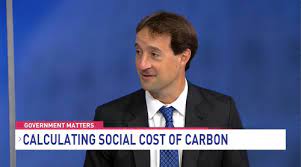As climate unravels before our eyes: lead authors and new revelations. Syee Weldeab: in a climate not much warmer than today, long-frozen methane on the sea floor released. Michelle Dvorak’s: Earth will cross 1.5 degrees of warming before 2030, and probably two degrees C in the 2050’s. Kevin Rennert: America underestimates climate damage and undervalues climate action. Three interviews!
Listen to or download this Radio Ecoshock show in CD Quality (57 MB) or Lo-Fi (14 MB)
REDISCOVERING THE CLATHRATE GUN
Buried in the ocean floor is a huge climate trap. Huge volumes of the super-warming gas methane are frozen inside cages of ice. They are called clathrates. If that methane thaws and gets into the atmosphere, a major civilization-ending warming could result. Many respected scientists doubt that could happen this century, or even this millennium. But new science suggests a past release of super-heating methane from the sea bed developed in warming similar to today.
The new paper was published August 22nd in the Proceedings of the National Academy. The title is: “Evidence for massive methane hydrate destabilization during the penultimate interglacial warming”, We have reached the lead author. Dr. Syee Weldeab is Associate Professor of Paleoclimatology at the University of California. Syee is part of the UC Santa Barbara Paleoclimate and Stable Isotope Lab.

Listen to or download this 21 minute interview with Syee Weldeab in CD Quality or LoFi
One of the co-authors in this clathrate study i Ralph R. Schneider of Kiel University, Germany. Schneider also co-authored a paper showing there were six major climate changes from the year 9000 Before Present right up to 150 years Before the Present Era. Most of these were global cooling, with more ice forming at the Poles, drying out of the tropics, and big atmospheric circulation changes. Weldeab himself authored a paper showing the drying out of Egypt and East Africa over the last few thousand years, based on sediment layers from the Nile River.
There are a lot of surprises in this new paper. Scientists went to the Gulf Of Guinea (the indent of the Atlantic along the coasts of Ghana and Nigeria). They brought up sea bed samples, layers over time. The samples contain shell remnants of tiny ocean life called “foraminifera”. Differences in the forms (isotopes) of oxygen in those shells reveal a record of temperature in the sea.
According to this record, there was a strange heat wave in the sea around 125,000 years ago. Climate then was only a little warmer than today, and the sea level temperatures were only about 1 degree C warmer than currently. But father down, in what oceanographers call the intermediate level, temperatures went up an astounding 6.8 degrees C – a hidden heat wave under the sea.
Heat around 125,000 years before present was high enough to thaw any frozen methane in the bottom. If that methane reached the atmosphere, it would drive a significant warming. Some scientists worry methane clathrates could thaw in our current warming, raising temperatures beyond what civilization could endure. But so far, there is no sign of that. Yes, methane in the atmosphere is increasing ominously, but studies show the added methane is coming mainly from tropical bogs and natural gas production. This paper shows a new mechanism to release frozen sea methane – warmer waters pouring off glacial melt.
WEAKENING AMOC
The Southern Polar ice sheet melted around 125,00 years ago. That was discovered by the glacial geologist Anders Carlson. But the new paper from Weldeab et al. suggest the ocean warming seen off the coast of Africa came from ice sheet collapse in Greenland. Note that Greenland is melting faster and faster as we warm the planet. Part of this theory about thawing methane rests on a change to the North Atlantic current called AMOC, the Atlantic Meridional Overturning Circulation. Here on Radio Ecoshock, I have interviewed a half dozen scientists whose work tracks weakening of the North Atlantic AMOC current in recent years.
The Weldeab paper says:
“Our findings imply that the methane oxidation across the entire water column and potential methane release to the atmosphere must have been a significant and widespread process...”
They also find that a relatively small weakening of the AMOC current system in the North Atlantic can lead to major changes in intermediate sea level temperatures (like around 1300 meters down).
Most of the interviews I’ve done on methane clathrate worries concern the Arctic, and the East Siberian sea bed in particular. Russian scientists Natalia Shakhova and Igor Semiletov have been warning about risks there for years. Several ship expeditions have not yet found clathrates thawing there in any significant quantity, at least not yet reaching the atmosphere. But methane is not frozen in ice only in Arctic regions. The clathrates are formed partly due to pressure, from all the sea water above them. These pockets of frozen methane are found in many parts of the world – even off the coast of tropical Africa.
This new paper got a lot of press coverage, including major media. But fear of clathrates is a story that returns every few years. It points to a huge risk, no doubt about that. But we do not yet have enough science to say WHEN seabed methane could be released. We don’t know the tipping point either. So this big risk could arise in the next couple of hundred years, or a few thousand years from now. We definitely need to be watchful and learn more.
There were small tribes of humans on Earth 125,000 years ago, mostly in Africa. Whatever methane burp or warming happened, they survived. We know that. In that changing climate, giant elephant-like creatures – Mastodons – had to move from today’s Texas and Florida all the way to the Yukon to escape the heat.
You can read more about this new science in this article by Bob Berwyn.
SUCCESS AGAINST THE ODDS
Dr. Syee Weldeab has his own story of survival. He was born in Eritrea, the war-torn East African country gaining independence from Ethiopia in 1993. His family hid Syee away with his grandparents in the country, where he literally herded animals, without any opportunity to attend school. As Syee tells us in this interview, at age 13 his extended family managed to get him out of the country to Germany, where he began to learn to read and write. Syee continued into University, got his PhD, and then Post Doctoral work, before emigrating to the University of California Santa Barbara in 2009.
For me, this story illustrates a vast human talent is hidden all over the world, awaiting more equal opportunities.
=============================================
MICHELLE DVORAK – A CLIMATE TOO HOT TOO SOON
You want to know the future climate, the real future? Are we already committed to a hotter Earth? How much hotter, how soon? Will climate action matter?
All these questions are tackled in an important new paper with an unassuming title: “Estimating the timing of geophysical commitment to 1.5 and 2.0 °C of global warming” The Lead Author is Michelle T. Dvorak. Michelle is a research scientist from the University of Washington in Tacoma.

Listen to or download this 18 minute interview with Michelle Dvorak in CD Quality or Lo-Fi
The headline story in this new science: even on a “moderate” emissions path, Earth will likely reach the 1.5 degree danger mark before 2030, and cross the 2 degree line some time before 2060. So expectations we could stay below those danger lines by 2100 seem misplaced. As UK scientist Bill McGuire writes in the Guardian newspaper (September 12, 2022):
“The UK Met Office, for one, forecast in 2021 that there was at least a 40% chance that 1.5C would be breached temporarily at least once in the following five years. This means the average temperature would be above 1.5C one year, but likely return below it the next – and we will fluctuate around that number before crossing it permanently some time in the future.”
In 2022, we are far from moderate emissions. In fact coal plants are increasing, and economic growth based on fossil fuels is still the model. It is heartening to see in this new work: the authors included all kinds of warming gases, not just carbon dioxide. So things like methane, nitrous oxide and various chlorinated warming gases are accounted for. That is partly what shortens the timeline before we cross the danger zones, compared to what the Paris Agreement envisioned.
The authors find two types of warming:
1. geophysical warming commitment
unrealized warming that is inevitable due to past emissions
2. socioeconomic warming commitment
warming associated with future, and therefore theoretically avoidable, emissions
WARMING BEFORE COOLING A BIT?
The new paper works on a fascinating quirk of the future. The climate is committed to boundaries like 1.5 degrees or 2 degrees, before actually reaching that warming. That is partly because when humans finally slash their fossil fuel burning, we also cut the aerosol pollution which helps cool the planet. How long would so-called temporary warming or overshoot last? According to this paper it could be 11 to almost 50 years!
During that time, a small warming would continue even though humans gave up fossil power to reach net zero emissions. Humans are not very patient and we are doubtful. People may get disappointed if temperatures get hotter after making sacrifices to get off fossil fuels.
Isn’t it possible that decades of hotter-than-final temperatures could trigger unexpected feedbacks and irreversible damage to other species, even if Earth then cools a few tenths of a degree? Yes and no. Some Earth systems respond quickly to global temperature change and would be sensitive to peak warming (for example, sea ice, the hydrological cycle, hurricanes, agriculture and many ecosystems), Other systems (like ocean heating and melting ice sheets) are much slower to respond, and would be less affected by the time of overshoot.
IS IT COMFORTING NEWS?
The Dvorak et al. paper says:
“This suggests that future warming is governed primarily by future emissions rather than by past emissions, and thus society is not geophysically committed to exceeding key global warming levels before reaching them.”
Corresponding to new science from Michael Mann, Kevin Trenberth and others, the team led by Dvorak assumes Earth temperatures will stabilize at whatever point we reach, when net zero emissions finally happens. Part of this new paper in Nature Climate Change seems almost comforting. We have not wrecked the climate yet, with past emissions. We may not go beyond 2 degrees in the long-run, depending on what we do. But the study leaves out giant feedbacks and possibilities, like shifting ocean currents, disappearing ice sheets, permafrost thaw, and all that.
Here is an article from Earth.com talking about this new science. The University of Washington Press Release is here.
========================================
KEVIN RENNERT – THE REAL COST OF CARBON
An American press release announces the real cost of carbon emissions is three times the current U.S. government estimate. Not very shocking. In America, there is no charge for dumping fossil fuel emissions straight into the atmosphere, no carbon tax. So who cares?
It turns out serious people worked on this for a few years, in a name-brand non-profit and at Berkeley. What is the real damage for every ton of carbon added? Can anyone calculate that in a future holding so much uncertainty? How do we work on climate action, in the real world, as it is? Let’s find out.
A new study on the social cost of carbon was published in the top journal Nature, September 1st, 2022. The paper is titled “Comprehensive Evidence Implies a Higher Social Cost of CO2”. We reached the Lead Author, Dr. Kevin Rennert. With a Doctorate in Atmospheric Science, Kevin worked in senior roles at the US Environmental Protection Agency, and as Advisor on Energy for the Senate Finance Committee. He is a Fellow and Director with the group Resources for the Future.

Listen to or download this 21minute interview with Kevin Rennert in CD Quality or Lo-Fi
THE REAL COST OF BURNING FOSSIL FUELS
In our interviews, most climate scientists calculate the cost of carbon in terms of raising the global average temperature, and then secondarily, resulting impacts like rising seas. This study tries to measure the economic cost, and even more broadly, the social cost of carbon.
Of course we need to include the best climate science, without giving too much weight to a perfect outcome or extinction-level disaster. This group found 2.6 degrees C. as a probable warming by the year 2100, and continuing to warm in following centuries. But that projection has a wide margin of error, because there are so many variables. For example, this study included things like expected population growth, and financial reactions.
THE MYSTERY OF DISCOUNTING
A final piece of the puzzle is very foreign to most of us: discounting. What is that, and what does discounting have to do with the price of carbon? Rennert and his colleagues published an update to the Social Cost program in 2021. Interest rates from the Federal Reserve and banks were at a historic low, practically nothing. Now they are rising. Most climate activists would be at a loss to see why interest rates have anything to do with pricing climate damage.
I thought “let’s leave this discounting complication to the experts”. But the former Trump Administration used this capitalist tool to drastically slash the cost of pollution. While the current government standard for the cost of carbon is $54 a ton, the Trump Administration changed the “discount rate” to make that cost only $6 a ton! That would mean the price of climate action, like installing renewables, wouldn’t be worth it, and pollution is cheap.
So it is important to get the cost of carbon right, even though the United States does not have a carbon tax. The Government does use a price of carbon in countless estimates and project planning. The Rennert group found the real social cost of carbon is about $185 a ton – triple the number used during the Obama and now Biden Administration. That means the cost of pollution is drastically underestimated, and the benefits of alternative energy and energy reduction are much greater than thought.
LESS CARING ABOUT PEOPLE DISTANT IN TIME
Another aspect of the new study in Nature is the problem of long-term damages from pollution now. Apparent solutions also require long term investments, of capital or tax-dollars, like investing in alternative energy, a new grid, an electric transportation fleet, and so on. But it seems the farther we look into the future, the less people care. It is called “empathetic distance”.
Here is a quote from the October 2021 article “Improving Discounting in the Social Cost of Carbon” by Prest, Pizer, and Richard Newell, CEO of Resources for the Future.
“The intuition is this: Society naturally values a dollar’s worth of avoided future climate impacts more if that impact is on a relatively poor society in the future. On the other hand, a dollar’s worth of future climate impacts has less value if it falls on a relatively rich future society.”
Find out a lot more about the real social cost of carbon at the Resources for the Future site, rff.org. RFF has a blog about this new science here. Their 2021 article is helpful too. Subscribers to the Washington Post can read this article about the new study and what it means. Or check this out in Grist.
DON’T FORGET TO SUPPORT RADIO ECOSHOCK!
This program keeps going because listeners donate. Radio stations do not pay for the show (all 106 stations are non-profit community radio). There are no advertisements in the program or on this site. I’m not selling hats or magic medicines, just breaking science direct from the scientists themselves. Please help pay the costs of producing and distributing the show.
And thank you to the show friend in New England who just gave us a major boost!
I’m Alex. Tune in next week for more breaking climate news. Thank you for listening, and caring about our world.
Interesting Michelle Dvorak says that by reducing methane & nitrous oxide we could observe some cooling. Presumably because these more potent GHgases are turbo-boosting global heating by increasing the total accumulation of the CO2-Equivalent GHgases.
So, because of their short-livedness, she has calculated that a total reduction in CH4 & N2O would result in a drop in mean global temperature (even whilst CO2 accumulation continues rising). That being so why isn’t there much more emphasis on their immediate reduction given that this seemingly provides more bangs for the buck in the short term?
However, the oceanographers likely won’t be predicting any cooling whilst the 93% of “additional” (GHG) global heating absorbed by the oceans, both discharges slowly into the atmosphere, & more immediately melts ice sheets buttressing glacial ice as well as warming (Ekman?) currents which penetrate into subsea permafrost & methane clathrate zones.